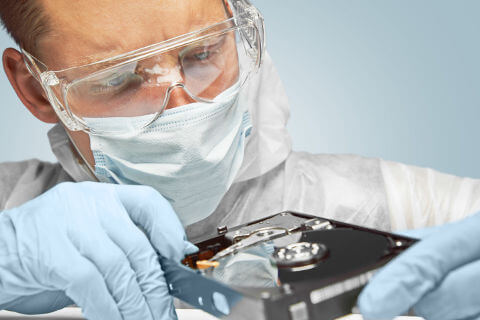Datarecovery.com engineers often use disk images to protect media or to rebuild large multi-drive systems efficiently. This guide explains what disk images are, how they’re used, and why they’re often important in the data recovery process.
If you need to recover files from a disk image, a hard drive, or another damaged device, call us at 1.800.237.4200 to set up a free evaluation.
What is a RAW Disk Image?
A disk image file is an exact bit-for-bit copy of an entire hard drive, solid-state drive, or optical disk. The image contain a complete copy of all of the data stored on the source drive – not just files and folders. A typical image will include the disk’s boot sector, file allocation tables or MFT (if applicable), volume attributes, directory forks, free space, and slack space.
A disk image is not a collection of files or folders. It is an exact duplicate of the raw data of the original disk, sector by sector, in the form of a single file. Disk images can be created for any hard drive, solid-state drive, or other storage device, and some operating systems have built-in mounting capabilities for virtual disks (for example, Linux and Unix).
Since disk images contain raw disk data, it is possible to create an image of a disk even if it is written in an unknown format or with an uncommon operating system. Disk images are extremely useful when backing up mission-critical systems, since the resulting image will retain the OS, files, settings, and various other data. Various programs can be used to create disk image files, including Stefan Fleischmann’s Winhex, a popular file utility.
How are Disk Images Used in Data Recovery?
We create disk images or clones of every functional hard drive that we recover, and in some cases, we work from mounted virtual disks instead of working directly with the original media. This limits our clients’ risks and substantially improves the chances of a full recovery if the original hard drive is not physically damaged or if it has been temporarily repaired as part of our data recovery process.
Logical disk images are especially helpful during RAID recovery. By creating images from RAID members, we can reconstruct an array logically without swapping out physical media. We can also use software to rebuild some types of RAID arrays without their controller cards. Finally, disk image files can allow our engineers to correct problems with data slippage, a problematic occurrence in which RAID data does not line up across multiple disks due to filesystem damage.
Disk images are extraordinarily beneficial during the data recovery process, and we use precise tools to obtain accurate images from client media. To learn more or to set up a case, call us today at 1.800.237.4200.





